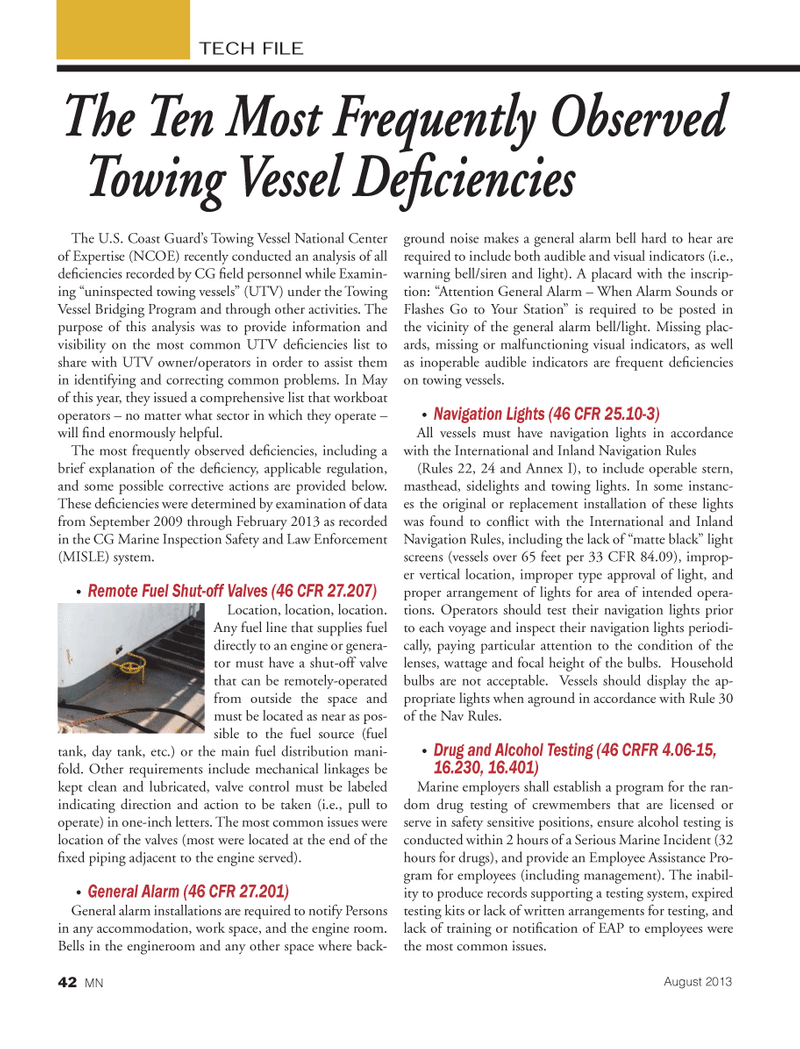
Page 42: of Marine News Magazine (August 2013)
Salvage & Response
Read this page in Pdf, Flash or Html5 edition of August 2013 Marine News Magazine
The U.S. Coast Guards Towing Vessel National Center of Expertise (NCOE) recently conducted an analysis of all de? ciencies recorded by CG ? eld personnel while Examin- ing uninspected towing vessels? (UTV) under the Towing Vessel Bridging Program and through other activities. The purpose of this analysis was to provide information and visibility on the most common UTV de? ciencies list to share with UTV owner/operators in order to assist them in identifying and correcting common problems. In May of this year, they issued a comprehensive list that workboat operators ? no matter what sector in which they operate ? will ? nd enormously helpful. The most frequently observed de? ciencies, including a brief explanation of the de? ciency, applicable regulation, and some possible corrective actions are provided below. These de? ciencies were determined by examination of data from September 2009 through February 2013 as recorded in the CG Marine Inspection Safety and Law Enforcement (MISLE) system.? Remote Fuel Shut-off Valves (46 CFR 27.207) Location, location, location. Any fuel line that supplies fuel directly to an engine or genera- tor must have a shut-off valve that can be remotely-operated from outside the space and must be located as near as pos-sible to the fuel source (fuel tank, day tank, etc.) or the main fuel distribution mani-fold. Other requirements include mechanical linkages be kept clean and lubricated, valve control must be labeled indicating direction and action to be taken (i.e., pull to operate) in one-inch letters. The most common issues were location of the valves (most were located at the end of the ? xed piping adjacent to the engine served). ? General Alarm (46 CFR 27.201) General alarm installations are required to notify Persons in any accommodation, work space, and the engine room. Bells in the engineroom and any other space where back- ground noise makes a general alarm bell hard to hear are required to include both audible and visual indicators (i.e., warning bell/siren and light). A placard with the inscrip- tion: Attention General Alarm ? When Alarm Sounds or Flashes Go to Your Station? is required to be posted in the vicinity of the general alarm bell/light. Missing plac- ards, missing or malfunctioning visual indicators, as well as inoperable audible indicators are frequent de? ciencies on towing vessels. ? Navigation Lights (46 CFR 25.10-3) All vessels must have navigation lights in accordance with the International and Inland Navigation Rules (Rules 22, 24 and Annex I), to include operable stern, masthead, sidelights and towing lights. In some instanc- es the original or replacement installation of these lights was found to con? ict with the International and Inland Navigation Rules, including the lack of matte black? light screens (vessels over 65 feet per 33 CFR 84.09), improp- er vertical location, improper type approval of light, and proper arrangement of lights for area of intended opera- tions. Operators should test their navigation lights prior to each voyage and inspect their navigation lights periodi- cally, paying particular attention to the condition of the lenses, wattage and focal height of the bulbs. Household bulbs are not acceptable. Vessels should display the ap- propriate lights when aground in accordance with Rule 30 of the Nav Rules. ? Drug and Alcohol Testing (46 CRFR 4.06-15, 16.230, 16.401) Marine employers shall establish a program for the ran- dom drug testing of crewmembers that are licensed or serve in safety sensitive positions, ensure alcohol testing is conducted within 2 hours of a Serious Marine Incident (32 hours for drugs), and provide an Employee Assistance Pro- gram for employees (including management). The inabil- ity to produce records supporting a testing system, expired testing kits or lack of written arrangements for testing, and lack of training or noti? cation of EAP to employees were the most common issues.The Ten Most Frequently Observed Towing Vessel De? ciencies Towing Vessel De? ciencies TECH FILE42 MNAugust 2013MN August2013 Layout 32-49.indd 427/23/2013 7:27:18 PM

 41
41

 43
43
